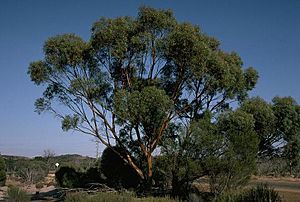Salt River gum facts for kids
Quick facts for kids Salt River gum |
|
|---|---|
 |
|
| Eucalyptus sargentii near Hyden | |
| Scientific classification | |
| Genus: |
Eucalyptus
|
| Species: |
sargentii
|
The Salt River gum (scientific name: Eucalyptus sargentii) is a special type of tree or bush found only in Western Australia. It's often called a "mallet" or "mallee." This plant has rough bark on its lower trunk and smooth bark higher up. Its leaves are long and narrow, and its flower buds grow in groups of seven. When it blooms, the flowers are white or creamy yellow, and its fruit looks like a small cone.
Contents
What the Salt River Gum Looks Like
The Salt River gum can be a tree or a mallee. A mallee is a type of eucalyptus that grows many stems from the ground. This plant usually grows between 3 and 12 meters (about 10 to 39 feet) tall. It often has smooth, greenish bark that turns brownish when it's new. The lower part of the trunk usually has rough, greyish bark that flakes off.
Its adult leaves are arranged one after another along the stem. They are green on both sides and shaped like a narrow spear or slightly curved. These leaves are usually 53 to 126 millimeters (about 2 to 5 inches) long and 5 to 13 millimeters (about 0.2 to 0.5 inches) wide. They narrow down to a stalk called a petiole, which is 5 to 18 millimeters long.
The flower buds grow where the leaves meet the stem. They appear in groups of seven on a single stalk called a peduncle, which is 7 to 20 millimeters long. Each individual bud has its own small stalk, called a pedicel, about 3 to 6 millimeters long.
When the buds are ready to open, they are long and oval-shaped, about 16 to 26 millimeters long and 4 to 5 millimeters wide. They have a horn-shaped cap, called an operculum, which is about twice as long as the base of the flower. Salt River gums usually flower from August or October to December or January. Their flowers are whitish to creamy yellow. After flowering, the plant produces a woody, cone-shaped fruit called a capsule, which is 6 to 9 millimeters long and 5 to 8 millimeters wide.
How It Got Its Name
The Eucalyptus sargentii was first officially described in 1924 by a botanist named Joseph Maiden. He wrote about it in his book, A Critical Revision of the Genus Eucalyptus. The second part of its scientific name, sargentii, was chosen to honor Oswald Hewlett Sargent. He was a pharmacist and a nature lover from a town called York.
Later, in 1992, two other botanists, Lawrie Johnson and Ken Hill, identified two different types (subspecies) of E. sargentii. These were E. sargentii subsp. fallens and E. sargentii subsp. sargentii. However, today, only E. sargentii subsp. sargentii is widely accepted as a distinct type.
In 2005, another botanist named Dean Nicolle described a new subspecies called E. sargentii subsp. onesis. This subspecies is different because it has a special woody swelling at its base called a lignotuber. This lignotuber helps the plant regrow if it's damaged, like by a bushfire. Subspecies onesis also grows as a dense, spreading mallee. The name onesis comes from an ancient Greek word meaning "advantage" or "use." This name refers to how this plant could be helpful in fixing salty soil.
Where Salt River Gum Grows
The Salt River gum grows in open woodlands. It prefers low-lying areas that don't drain water very well, often near salt lakes and salt creeks. You can find these trees scattered across an area from Pithara down to Lake Grace in Western Australia.
The subspecies onesis is found in only a few specific places. These locations are between Piawaning, York, and Cunderdin.
How We Protect It
The Western Australian Government's Department of Parks and Wildlife keeps track of how many Salt River gums there are.
The subspecies sargentii is considered "not threatened." This means there are enough of them, and they are not in danger of disappearing.
However, the subspecies onesis is listed as "Priority Three." This means that we don't know a lot about it, and it's only found in a few places. While it's not in immediate danger, it's important to keep an eye on these populations to make sure they stay safe.

